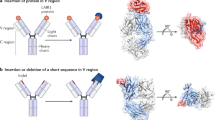Abstract
The antibody molecule possesses a number of so-called unconventional binding sites in the variable domain that are expressed and function independently from the antigen-binding site. These sites are encoded in the germiline, predominantly in framework residues. By this definition, these sites function as part of the innate immunity, and are not subject to antigendriven mutation and maturation. In this article, we focus on the evidence for the function and utility of the self-binding domain. The self-binding or autophilic domain has been discovered on murine germline-encoded antibodies from the S107/T15 Vh family. Autophilic antibodies form self-complexes after attaching to targets, but remain monomeric in solution. A peptide has been identified that confers self-binding if chemically attached to antibodies. Because this modification enhances the overall avidity of antibodies for target binding, therapeutic and diagnostic antibodies can be biotechnologically improved.
The concept of super antibodies is introduced here to describe the unique coexistence and synergism of acquired immunity with innate immunity via antigen-specific and unconventional functional domains. As not every antibody qualifies as a super antibody, biotechnology engineering can produce superantibodies with superior targeting and therapeutic properties.
Similar content being viewed by others
References
Eldeman, G. M., Cunningham, B. A., Gall, W. E., Gottlieb, P. D., Rutishauser, U., and Wasdal, M. J. (1969) Proc. Nat. Acad. Sci. USA 63, 78–82.
Fleischmann, J. B., Pain, R. H., and Porter, R. R. (1962), Arch. Biochem. Biophys. Suppl. 1, 174–192.
Hilschmann, N. and Craig, L. C. (1962) Proc. Natl. Acad. Sci. USA 53, 14013–1406.
Kohler, H., Shimizu, A., Paul, C., and Putnam, F. W. (1970), Nature 227, 1318–1321.
Kobat, E. A. and Wu, T. T. (1971), Ann. NY Acad. Sci. 190, 2019–2021.
Pojak, R. J., Amzel, L. N., Chen, B. L., Phizackerley, R. P., and Saul, F. (1974), Proc. Natl. Acad. Sci. USA 71, 3440–3444.
Silverman, G. J. (1997), Immunol. Today 18, 379–386.
Silverman, G. J. (1997), Int. Rev. Immunol., 14, 259–290.
Rajagopalan, K., Pavlinkova, G., Levy, S., Pokkuluri, P., Schiffer, M., Haley, B. E., and Kohler, H. (1996), Proc. Natl. Acad. Sci. USA 93, 6019–6024.
Kang, C-Y., Brunck, T. K., Kieber-Emmons, T., Blalock, J. E., and Kohler, H. (1988), Science 240, 1034–1036.
Paul, S., Volle, D. J., Beach, C. M., Johnson, D. R., Powell, M. J., and Massay, R. J. (1989), Science 244, 1158–1162.
Shoenfeld, Y. and George, J., (1997), Ann. NY Acad. Sci. 815, 342–349.
Kang, C-Y., Cheng, H-L., Rudikoff, S., and Kohler, H. (1987), J. Exp. Med. 165, 1332–1337.
Greenspan, N. S., Dacek, D. A., and Cooper, L. J., (1989), FASEB J. 10, 2203–2207.
Kang, C.-Y. and Kohler, H. (1986), J. Exp. Med. 163, 787–791.
Kaveri, S., Halpern, R., Kang, C-Y., and Kohler, H. (1991), Mol. Immunol. 2, 733–778.
Potter, M., and Leon, M. A. (1968), Science 162, 369–371.
Xiyun, Y., Evans, S. V., Kaminki, M. J., Gillies, S. D., Reisfeld, R. A., Noughton, A. N., and Chapman, P. B. (1996) J. Immunol. 157, 1582–1588.
Briles, D. E., Forman, S., Hudak, S., and Claflin, J. L. (1982), Eur. J. Immunol. 14, 1027–1030.
Lim, P. L., Choy, W. F., Chan, S. T., and Ng, S. S. (1994), Infect. Immun. 62, 1658–1661.
Lee, W., Cosenza, H., and Kohler, H. (1974), Nature 247, 55–57.
Rodwell, J. D., Alvarez V. L., Lee, C., Lopes, A. D., Goers, J. W., King, H. D., Powsner, H. J., and McKearn, T. J. (1986). Proc. Nat. Acad. Sci. USA 83, 2632–2636.
Pharm. Res. & Manufact. America, 1998 Biotechnology Survey.
Tutt, A. L., French, R. R., Illidge, T. M., Honeychurch, J., McBride, H. M., Penfold, C. A., Fearon, D. T., Parkhouse, R. M. E., Klaus, G. G. B., and Glennie, M. J. (1998), J. Immunol. 161, 3176–3185.
Kohler, H., and Paul, S. (1998), Immunol. Today 19, 221–227.
Author information
Authors and Affiliations
Rights and permissions
About this article
Cite this article
Kohler, H. Superantibodies. Appl Biochem Biotechnol 83, 1–12 (2000). https://doi.org/10.1385/ABAB:83:1-3:1
Issue Date:
DOI: https://doi.org/10.1385/ABAB:83:1-3:1




